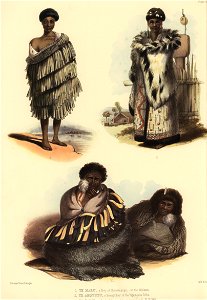I. Te maru, a boy of koruakopopo, on the waikato. Ii. Te amotutu, a young chief of the nga-ti-pou tribe. Iii. Ko tariu, a chief of taupo, and his principal wife, e pori. [image of page 100]
plate xliii. Te maro. A boy of waikato. The accompanying portrait was painted at koruakopopo, a small and picturesque village on the banks of the waikato river. Te maro is son of an inferior chief belonging to the great waikato division: he is about sixteen years of age, and wears his hair cropped short according to the prevailing custom; his dress is a variety of the kakahu, the dried flax leaves being fastened on in rows into the fabric beneath. Te amotutu. A young chief of nga-ti-pou tribe. This lad is about the same age with te maro, and belongs to te whero-whero's people, about fifty miles further up the waikato than komakopo. Te amotutu has been living as mission lad with mr. Ashwell, at the church missionary station of pepepe on the waikato; he is a fine intelligent youth, and at the time of my painting his portrait had been married about six weeks to an equally juvenile and very handsome bride at kaitote pah, to whom he had been long betrothed by his parents. Ko tariu. A chief of taupo, with his wife. This is the chief who was anxious to destroy all my sketches, as a punishment for my having represented places and objects that were tapu, and had it not been for the interference of my friend te heuheu, who had offered me his protection whilst at taupo, i should doubtless have lost a portion of my collection. Ko tariu lost his right eye in an expedition against wanganui, and was formerly a distinguished warrior. He has the favorite pipe in his mouth, the use of tobacco having extended all over the interior of the island, the natives become inveterate smokers, and tobacco the principal article of barter amongst them. His wife is an excellent specimen of a primitive maori woman in her every day costume. Date: 1847.
Loading...
